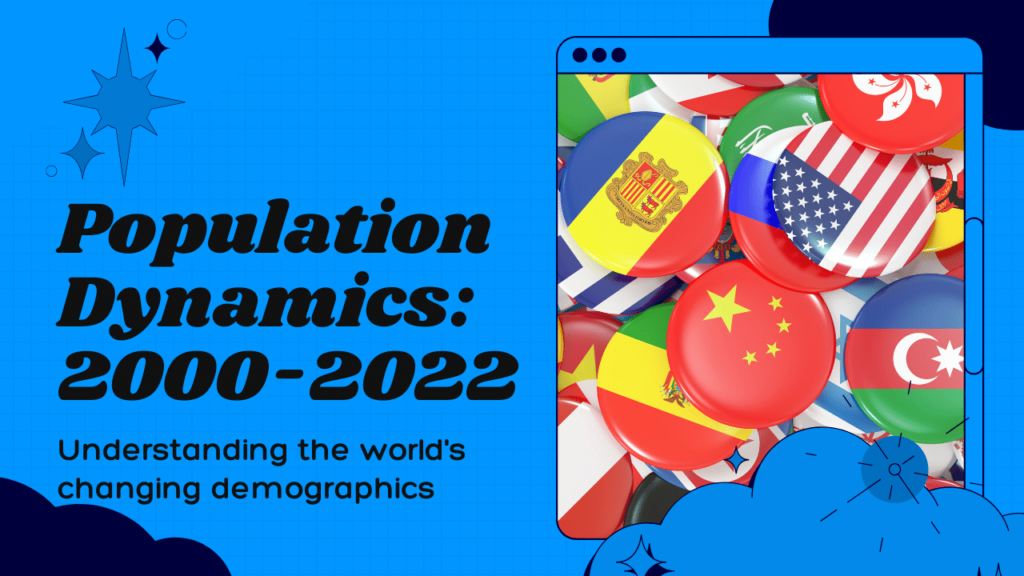Embarking on a journey through the intricate tapestry of global population demographics, one encounters a narrative woven with numbers that resonate far beyond mere statistics. The flux of populations across nations is a pivotal force shaping economies, societies, and the environment. Join us as we unravel the enigma of global population shifts, scrutinizing trends spanning from 2000 to 2022, and explore the plausible causes, far-reaching effects, and intriguing future projections.

Global Population in 2000: A Snapshot of Diversity
In the dawn of the new millennium, the world witnessed a kaleidoscope of population figures. Japan stood resilient with 126 million, while India’s colossal populace reached 1 billion. Croatia and Latvia, albeit smaller in scale, held populations of 4.4 million and 2.3 million, respectively.
The Unfolding Drama of 2022: A Tale of Transformation
Fast forward to the present, and the global population landscape has undergone significant metamorphosis. Japan’s headcount slightly receded to 125 million, hinting at subtle demographic shifts. India, in stark contrast, soared to an unprecedented 1.4 billion. Croatia and Latvia, however, experienced reductions, settling at 3.8 million and 1.9 million, respectively.
| Country | Population in 2000 (millions) | Population in 2022 (millions) | Change (millions) |
|---|---|---|---|
| 🇯🇵 Japan | 126 | 125 | -1 |
| 🇮🇳 India | 1,000 | 1,400 | +400 |
| 🇭🇷 Croatia | 4.4 | 3.8 | -0.6 |
| 🇱🇻 Latvia | 2.3 | 1.9 | -0.4 |
Deciphering the Dynamics: Unmasking the Anonymity
Japan’s Demographic Decline: Navigating Challenges
The nuanced decline in Japan’s population sparks inquiries into the nation’s demographic challenges. An aging populace, dwindling birth rates, and limited immigration collectively contribute to this downward trend. The economic implications are profound, with a contracting workforce posing challenges for sustained growth.
India’s Soaring Numbers: Balancing Act of Opportunities and Challenges
India’s population surge tells a tale of a nation navigating a delicate balance. Improvements in healthcare, sanitation, and overall living conditions have bolstered life expectancy. Simultaneously, persistent high birth rates underscore the challenges of managing such a vast population, presenting both opportunities and socio-economic challenges.
Also Read: China Population is Also Shrinking
Croatia and Latvia: A Divergence in Trajectories
The contrasting population reductions in Croatia and Latvia spotlight diverse dynamics. Croatia, grappling with emigration and low birth rates, faces the profound impact on its workforce and economy. Meanwhile, Latvia’s decline is a result of a dual challenge—emigration and an aging population—signaling potential strains on healthcare and pension systems.
Effects on Societies and Economies: A Global Canvas
The ripples of population shifts extend beyond borders, influencing societies and economies in unique ways.
Economic Impacts: The Butterfly Effect of Demographics
Declining populations in Japan, Croatia, and Latvia often correlate with economic challenges. A shrinking workforce may lead to labor shortages, acting as a hindrance to economic growth. Conversely, rapidly growing populations in India present opportunities for a youthful workforce but demand effective strategies for employment and resource management.
Social Dynamics: Navigating the Age Quandary
Societies grapple with the effects of aging populations and skewed age distributions. The strain on healthcare and pension systems becomes evident, necessitating innovative solutions. Large and youthful populations, as seen in India, may require robust education and employment frameworks to harness their potential positively.
Future Projections and Global Perspectives: Peering into the Crystal Ball
Predicting the future of global population trends is akin to navigating uncharted waters, influenced by a myriad of factors.
Demographic Policies: Shaping Tomorrow through Today’s Choices
Nations facing population decline may adopt policies to incentivize family growth or attract skilled immigrants. Conversely, countries with burgeoning populations might focus on family planning and education initiatives to manage growth sustainably. The choices made today will sculpt the demographic landscape of tomorrow.
Technological Advancements: The X-Factor in Demographic Evolution
The role of technology in shaping demographics cannot be understated. Advancements in healthcare, fertility treatments, and artificial intelligence may introduce unforeseen variables, influencing birth rates, life expectancy, and migration patterns. The intersection of technology and demography will undoubtedly redefine the contours of our global population landscape.
Conclusion: Navigating the Crossroads of Demographic Evolution
As we unravel the complex narrative of global population shifts, we find ourselves standing at the crossroads of challenges, opportunities, and uncertainties. The decreasing numbers in some nations prompt introspection, while the surges in others demand strategic planning. The global community, irrespective of borders, must collaborate, innovate, and adapt to ensure a sustainable and thriving future. The keyword, “population,” resonates throughout this discourse, echoing its relevance in shaping our shared destiny. The journey continues, and the enigma of global population dynamics remains an ever-evolving story waiting to be written.
